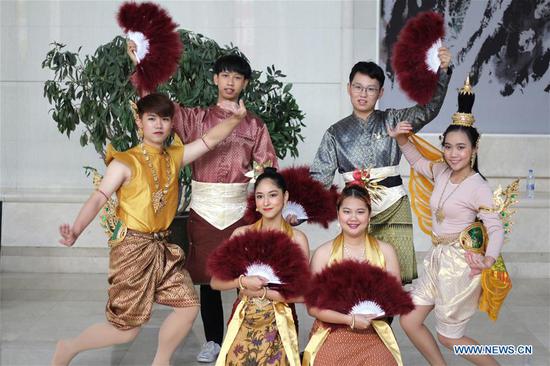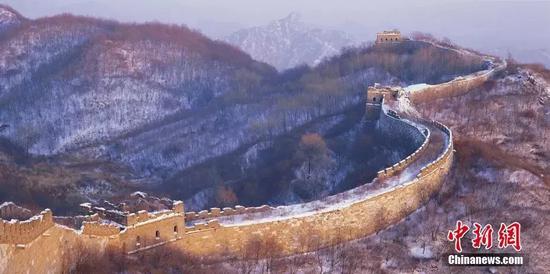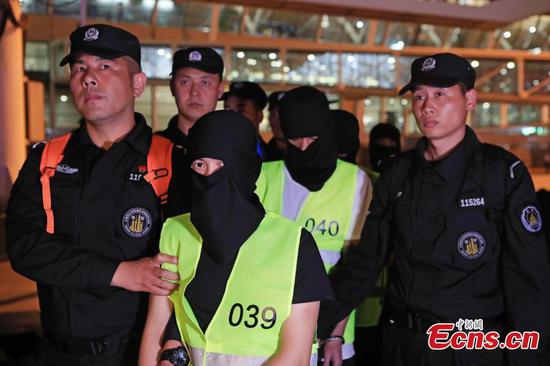
Photo taken on May 13, 2019 shows the bow and the strings of an Erhu in Lanzhou, northwest China's Gansu Province. Erhu, sometimes known as the Chinese violin or Chinese two-stringed fiddle, is a Chinese traditional two-stringed bowed musical instrument. It is used as a solo instrument as well as in small ensembles and large orchestras. Erhu, traced back to ancient Chinese Tang dynasty (618-907), is now used in both traditional and contemporary music arrangements, such as in pop, rock and jazz. The famous solo pieces include Er Quan Ying Yue (Two Springs Reflecting the Moon) by Abing and Sai Ma (Horse Race) by Huang Haihuai. (Xinhua/Fan Peishen)

Erhu performer Zhang Zhijun (C) poses for a group photo with his students in Lanzhou, northwest China's Gansu Province, May 13, 2019. Erhu, sometimes known as the Chinese violin or Chinese two-stringed fiddle, is a Chinese traditional two-stringed bowed musical instrument. It is used as a solo instrument as well as in small ensembles and large orchestras. Erhu, traced back to ancient Chinese Tang dynasty (618-907), is now used in both traditional and contemporary music arrangements, such as in pop, rock and jazz. The famous solo pieces include Er Quan Ying Yue (Two Springs Reflecting the Moon) by Abing and Sai Ma (Horse Race) by Huang Haihuai. (Xinhua/Fan Peishen)

Photo taken on May 13, 2019 shows the vibrating skin of an Erhu in Lanzhou, northwest China's Gansu Province. Erhu, sometimes known as the Chinese violin or Chinese two-stringed fiddle, is a Chinese traditional two-stringed bowed musical instrument. It is used as a solo instrument as well as in small ensembles and large orchestras. Erhu, traced back to ancient Chinese Tang dynasty (618-907), is now used in both traditional and contemporary music arrangements, such as in pop, rock and jazz. The famous solo pieces include Er Quan Ying Yue (Two Springs Reflecting the Moon) by Abing and Sai Ma (Horse Race) by Huang Haihuai. (Xinhua/Fan Peishen)
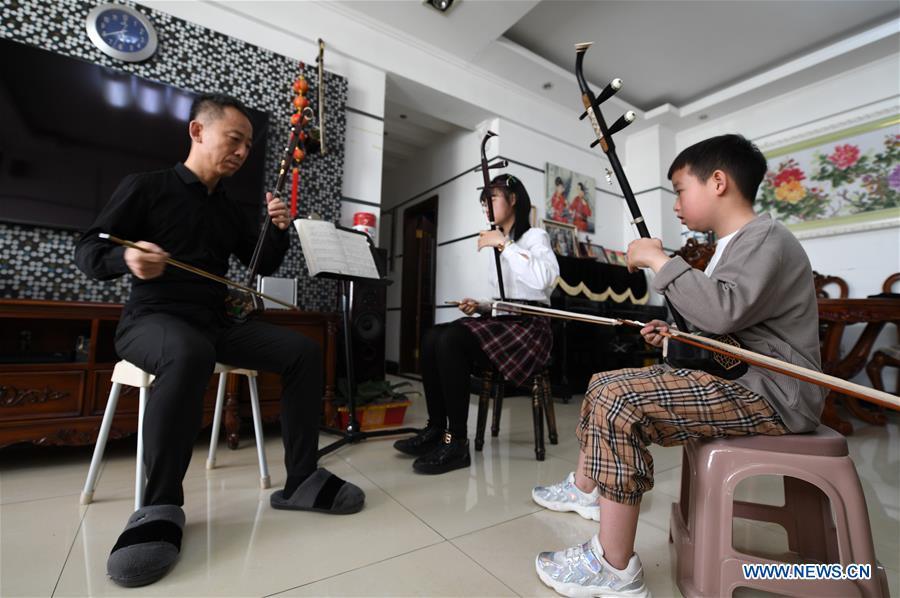
Erhu performer Zhang Zhijun (1st L) instructs his students in Lanzhou, northwest China's Gansu Province, May 13, 2019. Erhu, sometimes known as the Chinese violin or Chinese two-stringed fiddle, is a Chinese traditional two-stringed bowed musical instrument. It is used as a solo instrument as well as in small ensembles and large orchestras. Erhu, traced back to ancient Chinese Tang dynasty (618-907), is now used in both traditional and contemporary music arrangements, such as in pop, rock and jazz. The famous solo pieces include Er Quan Ying Yue (Two Springs Reflecting the Moon) by Abing and Sai Ma (Horse Race) by Huang Haihuai. (Xinhua/Fan Peishen)
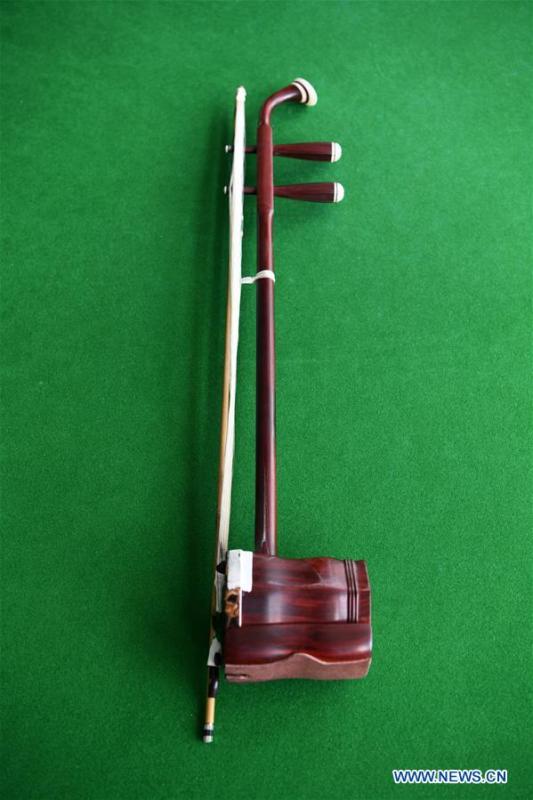
An Erhu is pictured in Lanzhou, northwest China's Gansu Province, May 13, 2019. Erhu, sometimes known as the Chinese violin or Chinese two-stringed fiddle, is a Chinese traditional two-stringed bowed musical instrument. It is used as a solo instrument as well as in small ensembles and large orchestras. Erhu, traced back to ancient Chinese Tang dynasty (618-907), is now used in both traditional and contemporary music arrangements, such as in pop, rock and jazz. The famous solo pieces include Er Quan Ying Yue (Two Springs Reflecting the Moon) by Abing and Sai Ma (Horse Race) by Huang Haihuai. (Xinhua/Fan Peishen)

Erhu performer Zhang Zhijun (R) instructs his student in Lanzhou, northwest China's Gansu Province, May 13, 2019. Erhu, sometimes known as the Chinese violin or Chinese two-stringed fiddle, is a Chinese traditional two-stringed bowed musical instrument. It is used as a solo instrument as well as in small ensembles and large orchestras. Erhu, traced back to ancient Chinese Tang dynasty (618-907), is now used in both traditional and contemporary music arrangements, such as in pop, rock and jazz. The famous solo pieces include Er Quan Ying Yue (Two Springs Reflecting the Moon) by Abing and Sai Ma (Horse Race) by Huang Haihuai. (Xinhua/Fan Peishen)
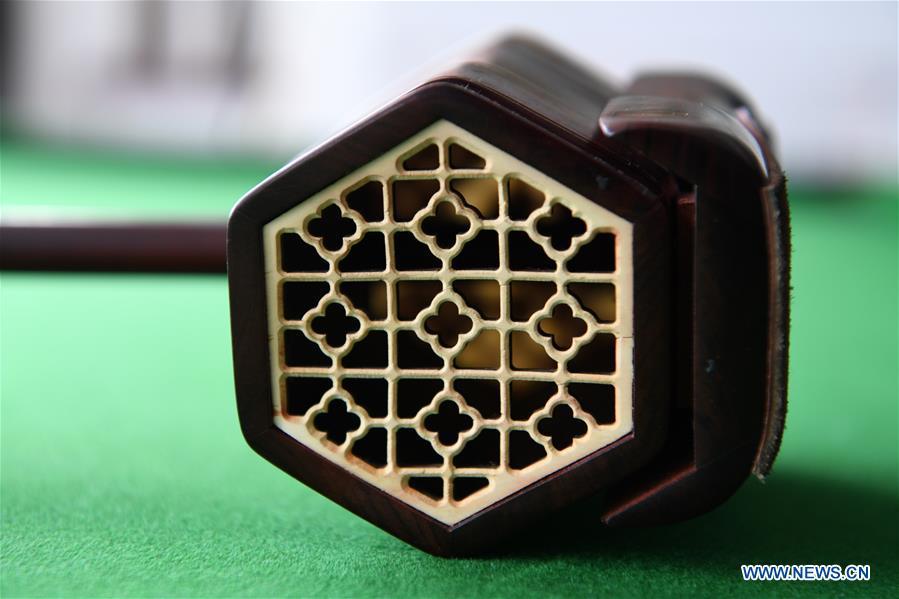
Photo taken on May 13, 2019 shows the resonator of an Erhu in Lanzhou, northwest China's Gansu Province. Erhu, sometimes known as the Chinese violin or Chinese two-stringed fiddle, is a Chinese traditional two-stringed bowed musical instrument. It is used as a solo instrument as well as in small ensembles and large orchestras. Erhu, traced back to ancient Chinese Tang Dynasty (618-907), is now used in both traditional and contemporary music arrangements, such as in pop, rock and jazz. The famous solo pieces include Er Quan Ying Yue (Two Springs Reflecting the Moon) by Abing and Sai Ma (Horse Race) by Huang Haihuai. (Xinhua/Fan Peishen)
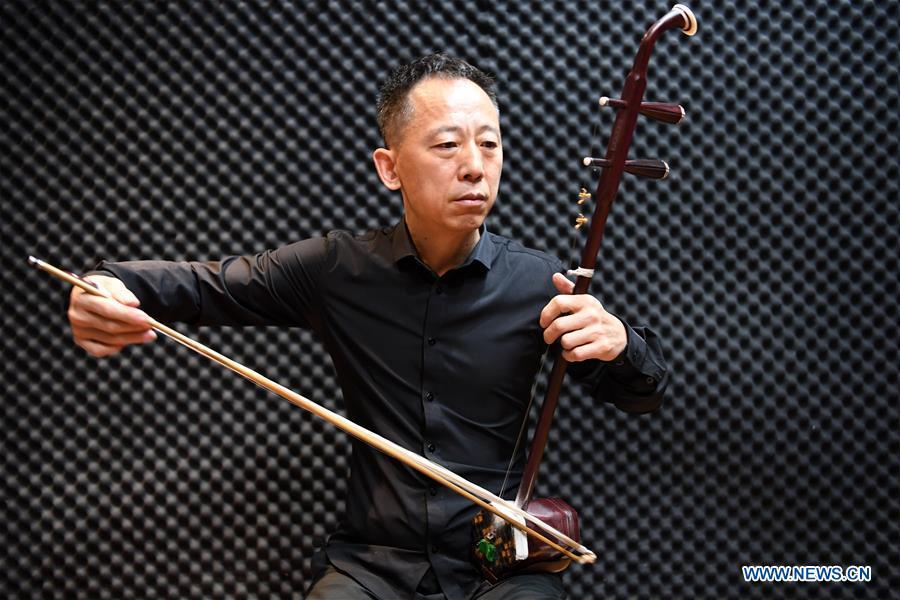
Erhu performer Zhang Zhijun plays Erhu in Lanzhou, northwest China's Gansu Province, May 13, 2019. Erhu, sometimes known as the Chinese violin or Chinese two-stringed fiddle, is a Chinese traditional two-stringed bowed musical instrument. It is used as a solo instrument as well as in small ensembles and large orchestras. Erhu, traced back to ancient Chinese Tang dynasty (618-907), is now used in both traditional and contemporary music arrangements, such as in pop, rock and jazz. The famous solo pieces include Er Quan Ying Yue (Two Springs Reflecting the Moon) by Abing and Sai Ma (Horse Race) by Huang Haihuai. (Xinhua/Fan Peishen)
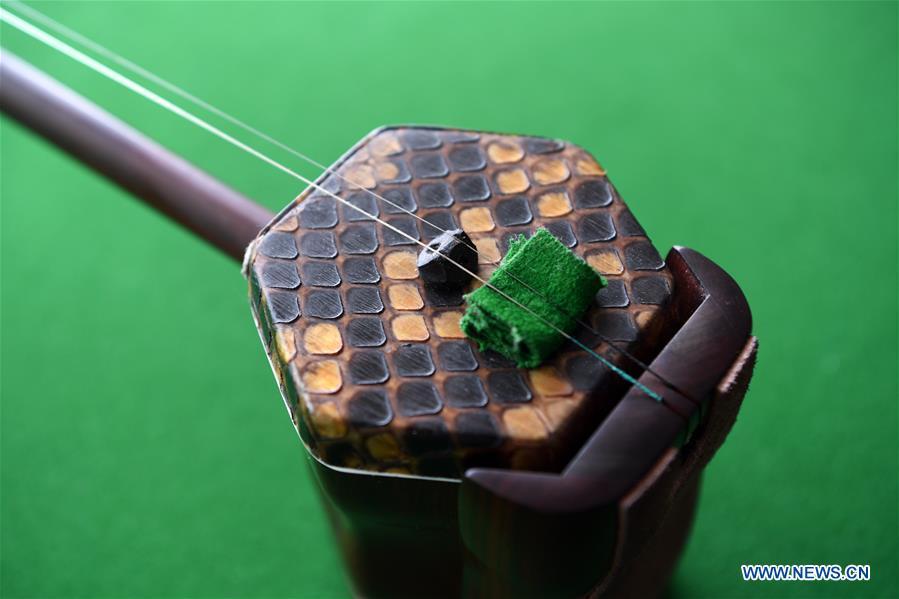
Photo taken on May 13, 2019 shows the vibrating skin of an Erhu in Lanzhou, northwest China's Gansu Province. Erhu, sometimes known as the Chinese violin or Chinese two-stringed fiddle, is a Chinese traditional two-stringed bowed musical instrument. It is used as a solo instrument as well as in small ensembles and large orchestras. Erhu, traced back to ancient Chinese Tang dynasty (618-907), is now used in both traditional and contemporary music arrangements, such as in pop, rock and jazz. The famous solo pieces include Er Quan Ying Yue (Two Springs Reflecting the Moon) by Abing and Sai Ma (Horse Race) by Huang Haihuai. (Xinhua/Fan Peishen)
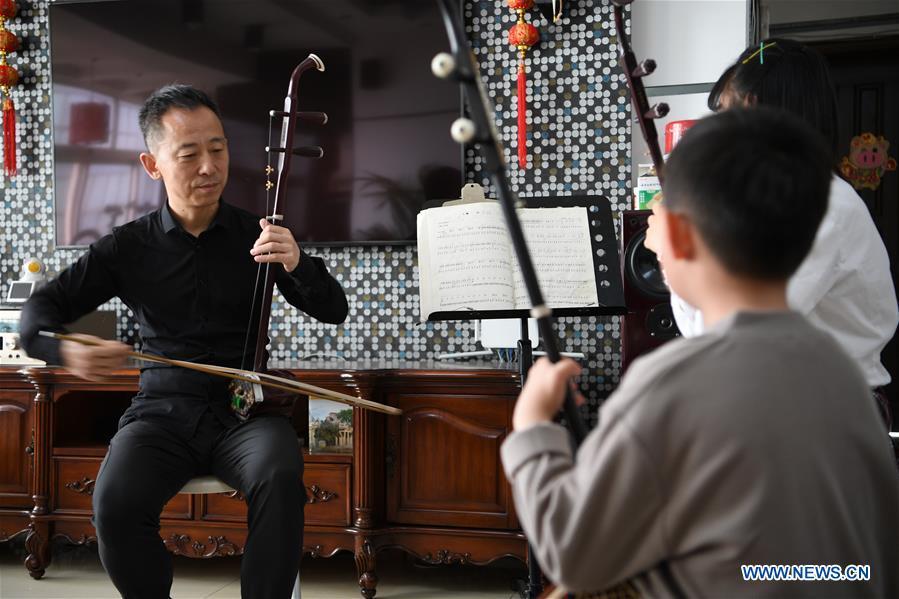
Erhu performer Zhang Zhijun (L) instructs his students in Lanzhou, northwest China's Gansu Province, May 13, 2019. Erhu, sometimes known as the Chinese violin or Chinese two-stringed fiddle, is a Chinese traditional two-stringed bowed musical instrument. It is used as a solo instrument as well as in small ensembles and large orchestras. Erhu, traced back to ancient Chinese Tang dynasty (618-907), is now used in both traditional and contemporary music arrangements, such as in pop, rock and jazz. The famous solo pieces include Er Quan Ying Yue (Two Springs Reflecting the Moon) by Abing and Sai Ma (Horse Race) by Huang Haihuai. (Xinhua/Fan Peishen)

An Erhu is pictured in Lanzhou, northwest China's Gansu Province, May 13, 2019. Erhu, sometimes known as the Chinese violin or Chinese two-stringed fiddle, is a Chinese traditional two-stringed bowed musical instrument. It is used as a solo instrument as well as in small ensembles and large orchestras. Erhu, traced back to ancient Chinese Tang dynasty (618-907), is now used in both traditional and contemporary music arrangements, such as in pop, rock and jazz. The famous solo pieces include Er Quan Ying Yue (Two Springs Reflecting the Moon) by Abing and Sai Ma (Horse Race) by Huang Haihuai. (Xinhua/Fan Peishen)

Photo taken on May 13, 2019 shows the tuning pegs and neck of an Erhu in Lanzhou, northwest China's Gansu Province. Erhu, sometimes known as the Chinese violin or Chinese two-stringed fiddle, is a Chinese traditional two-stringed bowed musical instrument. It is used as a solo instrument as well as in small ensembles and large orchestras. Erhu, traced back to ancient Chinese Tang dynasty (618-907), is now used in both traditional and contemporary music arrangements, such as in pop, rock and jazz. The famous solo pieces include Er Quan Ying Yue (Two Springs Reflecting the Moon) by Abing and Sai Ma (Horse Race) by Huang Haihuai. (Xinhua/Fan Peishen)
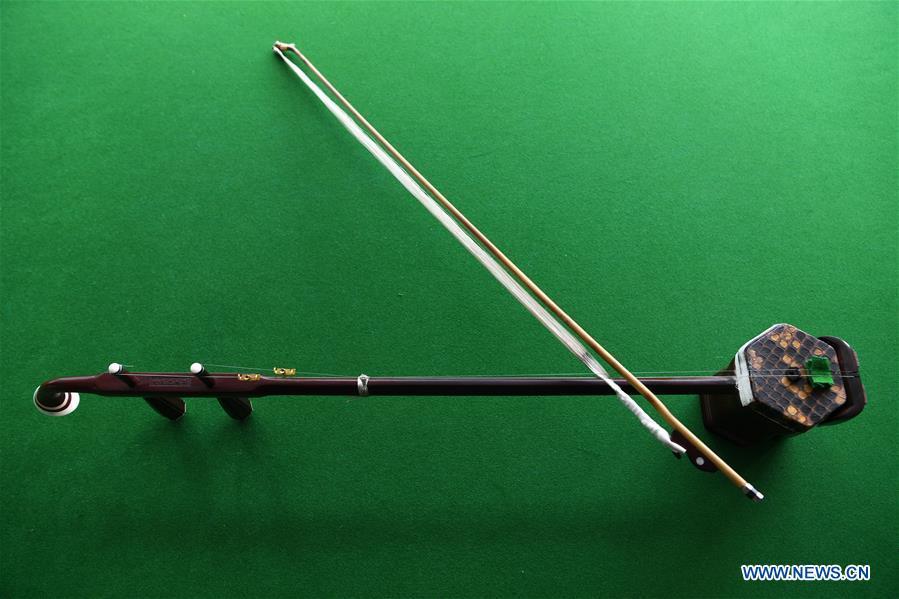
An Erhu is pictured in Lanzhou, northwest China's Gansu Province, May 13, 2019. Erhu, sometimes known as the Chinese violin or Chinese two-stringed fiddle, is a Chinese traditional two-stringed bowed musical instrument. It is used as a solo instrument as well as in small ensembles and large orchestras. Erhu, traced back to ancient Chinese Tang dynasty (618-907), is now used in both traditional and contemporary music arrangements, such as in pop, rock and jazz. The famous solo pieces include Er Quan Ying Yue (Two Springs Reflecting the Moon) by Abing and Sai Ma (Horse Race) by Huang Haihuai. (Xinhua/Fan Peishen)

Erhu are pictured in Lanzhou, northwest China's Gansu Province, May 13, 2019. Erhu, sometimes known as the Chinese violin or Chinese two-stringed fiddle, is a Chinese traditional two-stringed bowed musical instrument. It is used as a solo instrument as well as in small ensembles and large orchestras. Erhu, traced back to ancient Chinese Tang dynasty (618-907), is now used in both traditional and contemporary music arrangements, such as in pop, rock and jazz. The famous solo pieces include Er Quan Ying Yue (Two Springs Reflecting the Moon) by Abing and Sai Ma (Horse Race) by Huang Haihuai. (Xinhua/Fan Peishen)
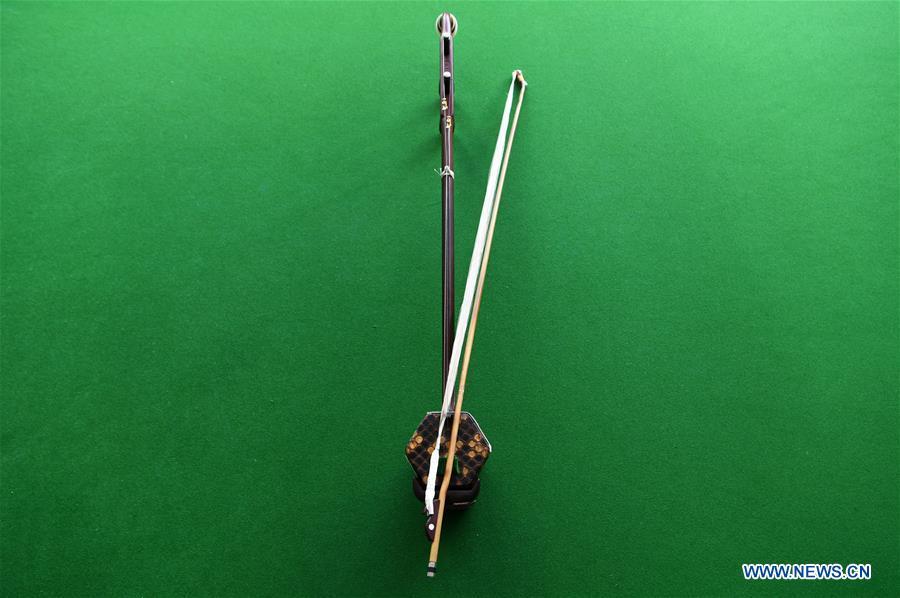
An Erhu is pictured in Lanzhou, northwest China's Gansu Province, May 13, 2019. Erhu, sometimes known as the Chinese violin or Chinese two-stringed fiddle, is a Chinese traditional two-stringed bowed musical instrument. It is used as a solo instrument as well as in small ensembles and large orchestras. Erhu, traced back to ancient Chinese Tang dynasty (618-907), is now used in both traditional and contemporary music arrangements, such as in pop, rock and jazz. The famous solo pieces include Er Quan Ying Yue (Two Springs Reflecting the Moon) by Abing and Sai Ma (Horse Race) by Huang Haihuai. (Xinhua/Fan Peishen)

